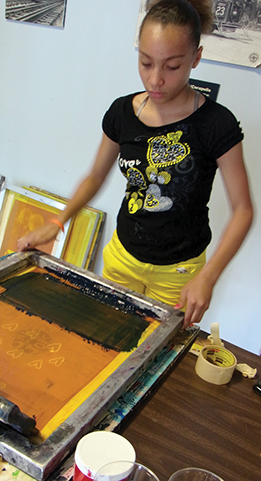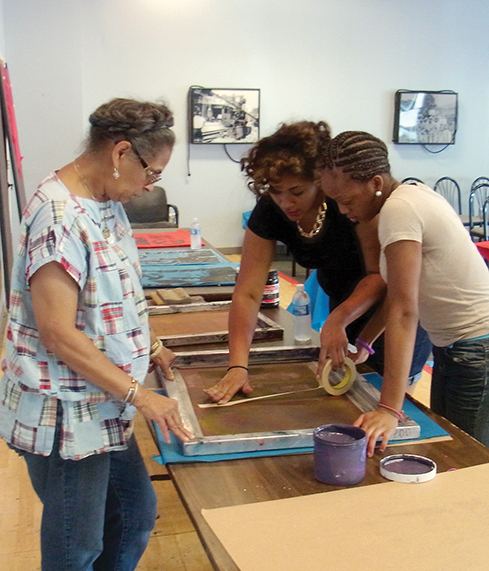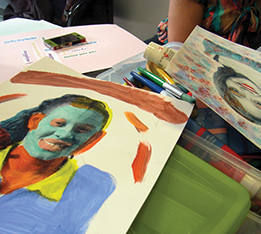 Winter 2013
Winter 2013|
“We really get to know each other. It’s come on over and have fun. It’s low-stress, make art, stay out of trouble.”
- Lauren Brown, a graduate of Power Up and now a mentor |
Girl Power
The Warhol gives girls a safe space to not only be themselves, but be the positive change they want to see in their community.
Around the table, three of her peers write their own words—Harmony, Love, Elevate, Powerful. They’re inscriptions of hope for their hometown of Homewood. Later, they’ll silkscreen them onto a big, multi-colored banner. Green and a small group of other teenage girls between the ages of 13 and 18 are part of The Andy Warhol Museum’s Power Up program. Their project this fall is to create a sprawling banner celebrating Homewood’s proud past. They hope the display will help to renew self-respect in a neighborhood battered by headlines about gangs, drugs, and poverty. “I think it’s cool,” Green says. “People think only bad things happen in Homewood; that it’s just people who don’t have any manners, and there are always killings. It’s not all like that. I think this will make them feel better about Homewood.” “It’s empowerment through the arts,” says Heather White, artists and communities program coordinator at The Warhol who co-teaches Power Up with artist-educator Katie Kaplan, a graduate of Warhol teen programs. Power Up’s goal is to equip young women to become advocates for themselves and change agents in their communities. The program, now in its fifth year, is held both in the summer and after school. The themes of each group’s art-making vary by semester, but they always incorporate the improvisational publishing practices of Andy Warhol. Previous semesters centered on obesity, women’s reproduction issues, and the environment— all as meaningful ways for the girls to think about the health and wellness of their community. Green and her peers, all of whom attend Westinghouse High School, meet weekly in the nearby Greater Pittsburgh Coliseum, a dominate building on Frankstown Road that also houses the Trolley Station Oral History Center. With support from The Sprout Fund’s Hive program, Power Up set up shop in Homewood to focus on a community that faces a 59 percent graduation rate, and where a staggering 82 percent of its young people live at or below the poverty line.
At the beginning of the semester, White and the girls discussed where to hang the 16-foot banner on the building’s exterior. The teens then helped design the concept—four 8-foot-tall H’s that stand for Homewood and radiate outward to create a feeling of energy. The teens also chose the color and designs. They cut the fabric with the help of Tina Brewer, an artist who operates the building with her husband, John, a longtime Homewood resident and historian and archivist for both the Trolley Station and the Pittsburgh Courier. Historic images plucked from the Courier archives and the Westinghouse High School Hall of Fame— displayed in the Coliseum’s lobby—will also be silkscreened onto the banner. The exercise of digging through old photos of the neighborhood’s heyday helped the girls consider the community’s past, and how the place they call home has changed over time. Green places a pattern for an H on a swatch of blue fabric and dissolves into a fit of giggles. Silliness is welcome here. It’s not an art class with a capital A. “We are just hanging out and making things,” White says. “They don’t need it to be so structured. They had a whole day of school.” The informal vibe gives the girls and their instructors time to talk about issues in school and at home, or anything else that’s on their minds. Lauren Brown, a recent graduate of the program and a student at Chatham University, now works with White as an artist-educator and a mentor to the girls. She sits around the table and talks to the teens as they prepare their prints. One girl grimaces as she looks down at her signature on the acetate. “This looks ugly,” she says. “You can’t mess up; it’s art,” Brown responds, reassuringly. She chats with another girl about a rumor circulating around school about the teen and offers to help another with a homework assignment.
The Warhol’s goal is to work with a small group of girls over many years and then offer them jobs as mentors at the end of the program. During the recent summer session of Power Up, the museum employed four program graduates, now college students. Taylor Eackles, 15, loves the program. It’s much more fun than going home and watching TV, she says, then adds, “We need to do this. There’s been a lot of bad things happening with rivals. This could help bring everyone together and bring memories from the past back.” Back in September, Brewer—who in 2010 was one of two artists who participated in the Homewood Artist Residency in collaboration with The Warhol, and whose work remains on permanent view at the Coliseum—asked the current group of girls to share their feelings about where they live. “They were pretty negative,” Brewer says. “They feel stuck. I let them know that I moved to this community 40 years ago. I made a choice to live here. “We have a whole community of young people,” she adds. “We want them to stay.” Brewer believes Power Up just might be a first step in that process. “They’re making a banner that is going to welcome people. It has their names on it, their imprint. This is a big deal for them. They are going to be stars in the community.”
|
What's Your Energy IQ? · A Playful, Soulful Spectacle · Energy in Human Form · For the Love of Bugs · Directors' Note · NewsWorthy · Face Time: Donald Warhola · Field Trip: Pop goes China · About Town: Art for All · The Big Picture
 |
Copyright © 2017 CARNEGIE Magazine. All rights reserved. |



